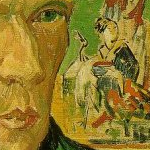
.jpg)
One of the interesting features for me in writing this book is that certain chapters are from other points of view. Even if the book is Vincent's life story, I don't always remain in his point of view. This isn't unusual, although perhaps a bit counterintuitive. Colum McCann, for example, did the same in his book Dancer, a fictional take on the life of Rudolf Nureyev. As with McCann's book, a reader of mine may not pick up on the logic of why certain chapters are presented from other points of view. All I can say is that the chapters had to be written that way. The other points of view were present from the first moments I imagined those scenes. I was working on one yesterday that featured a party in Monmartre attended by many people Vincent knew there. The point of view character is Suzanne Valadon (there she is on the right, as portrayed by Renoir, and on the left as she portrayed herself) , a painter who ran with the Neoimpressionist crowd, modeled for some of them, and eventually earned well-deserved esteem for her work. In this case, there's a very specific reason why I presented the scene from Valadon's point of view. She did attend a party that Van Gogh went to and, years later, documented her observations about him. Anyone who looks into Van Gogh's biography will probably come across Valadon's recollection of that party. In doing the party scene it was Valadon's recollection that guided me from the start.
But here's something I've noticed, both in my own chapters and in real life research. Those who offered first person recollections of Van Gogh often remembered a man who is much more quirky, temperamental, and even anti-social than the Van Gogh I see in his own letters. So both in my book and in historical data, pictures of a canny and empathetic man butt up against pictures of a driven, self-involved, bewildering crank. Am I muddling the picture of my protagonist to a dangerous degree? Or am I presenting an interesting, real worldly complexity. After all, how we think of ourselves, how person X thinks of us, how person Y thinks of us, and how person Z thinks of us can be wildly divergent notions. The phenomenon I'm noting with Van Gogh is probably no different than it would be for most people, if others (years later) took the time to write down recollections of them. And in Van Gogh's case, the reputation of a man who cut off his own ear and eventually shot himself had to have embedded itself in people's minds. I think it may be true that in retrospect people remember a Van Gogh that was more erratic than the real man. Or maybe that's an excuse, an apology. But I think it makes sense. But too finally it's irrelevant to my dilemma, which is: should I keep these different pictures of my protagonist together, sometimes side-by-side? Will that help or hinder my novel? For now, they're in. Complexity is normally a good thing for main characters. It's not bad if mine demonstrates some. But with that said, I'm a long way from being done and from having made final decisions.













0 comments:
Post a Comment